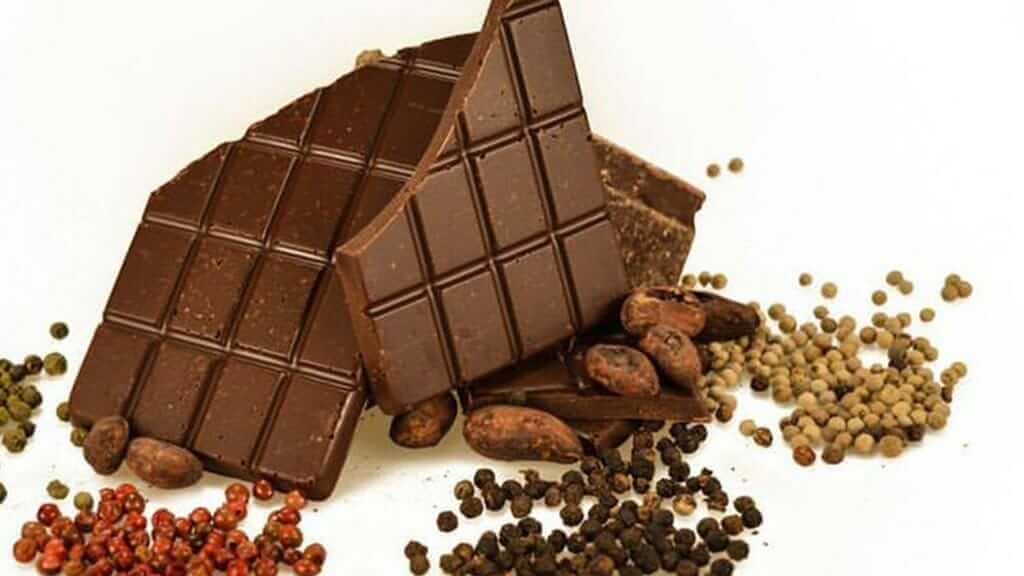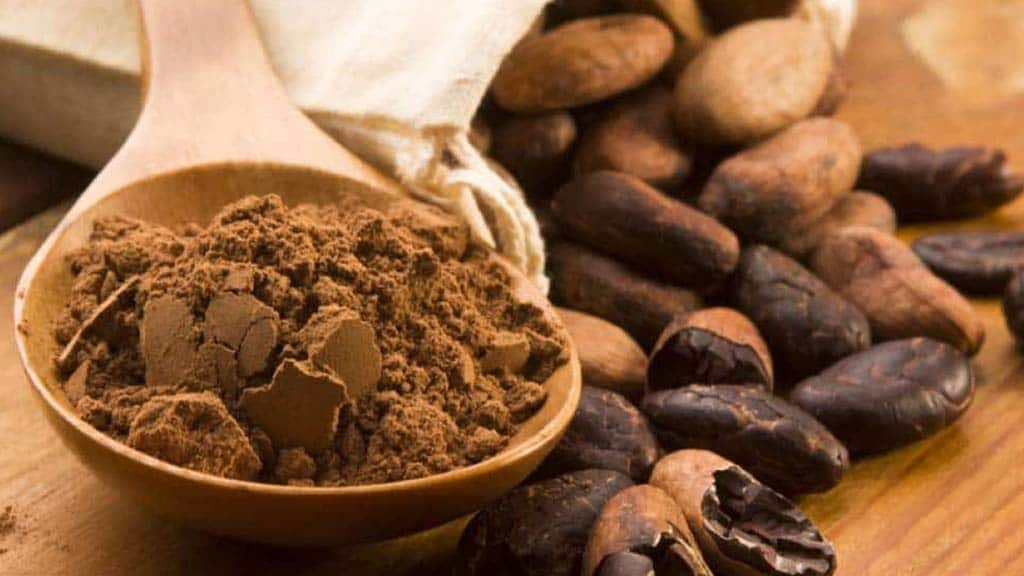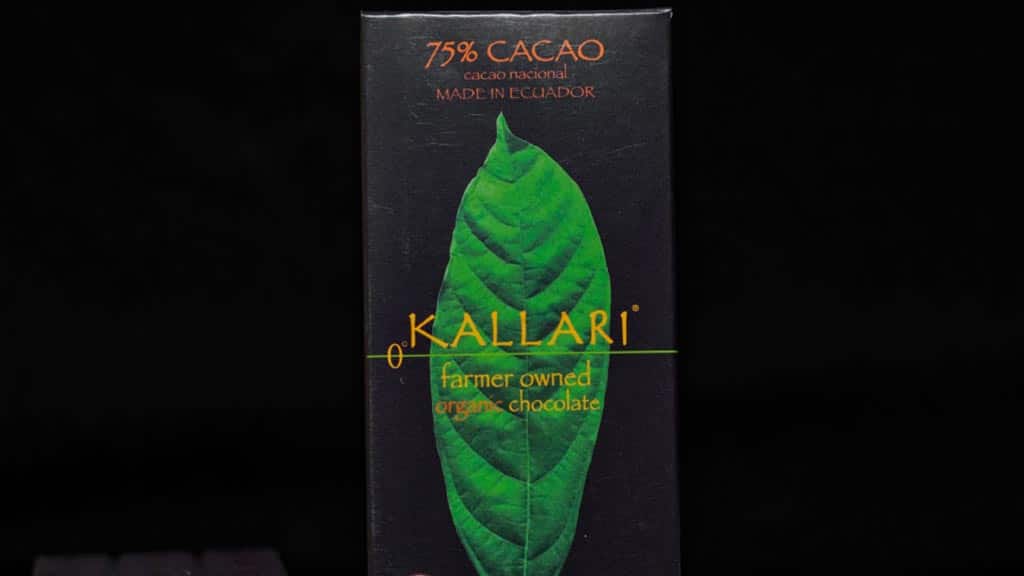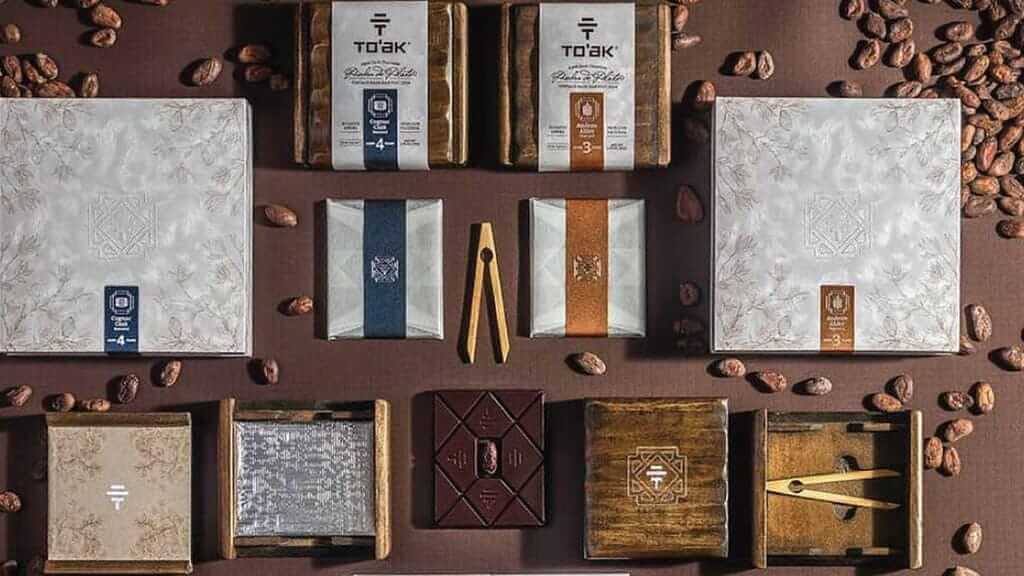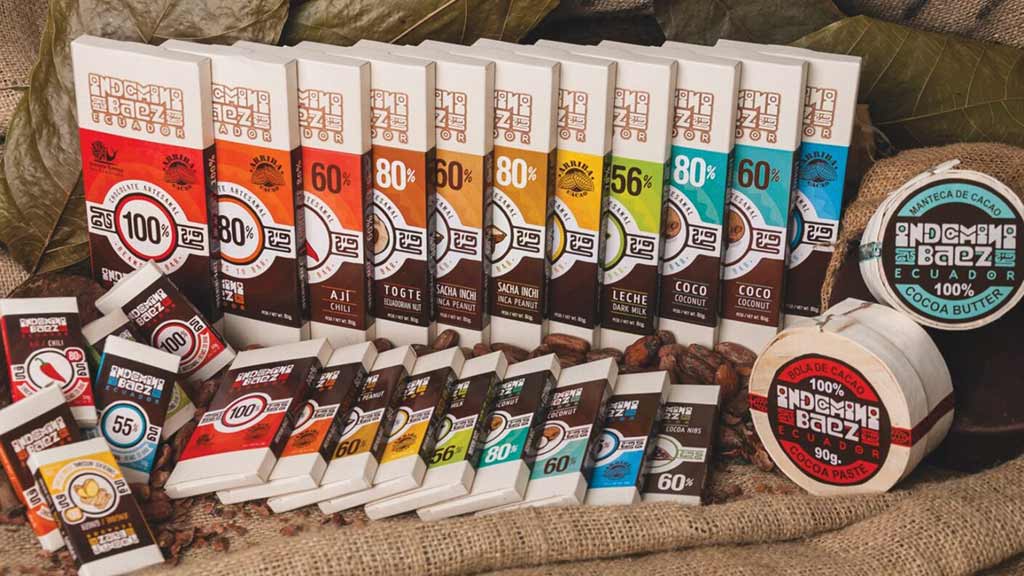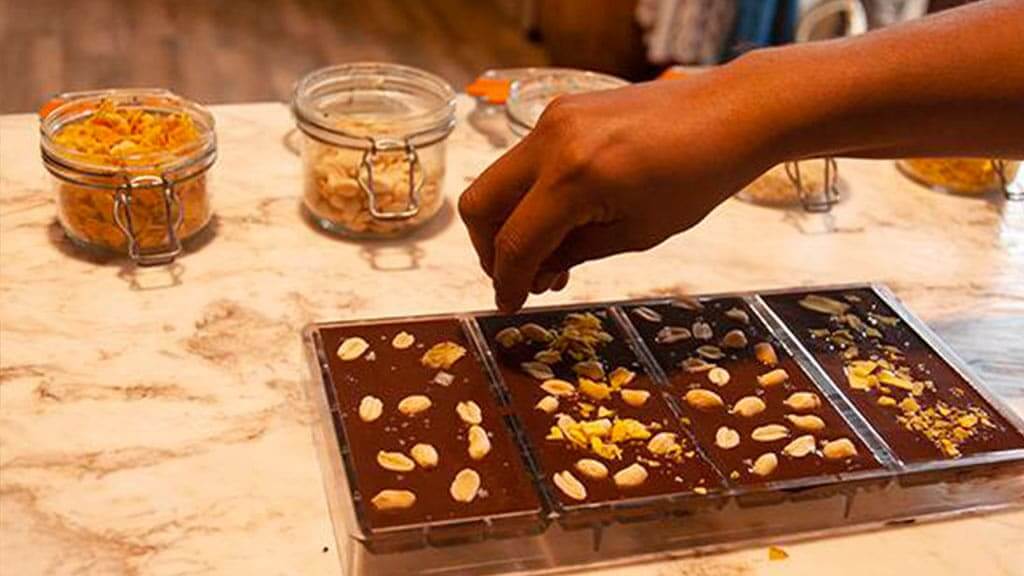Ecuadorian Chocolates & Cacao
Does Ecuador have good chocolate? Absolutely! In fact, Ecuadorian chocolates have received global awards and recognition for their fine quality over recent years.
Whereas Ecuador’s best cocoa beans used to be exported, today they stay in the country to be transformed into delicious Ecuadorian chocolate bars. An exciting new trend for fine Ecuadorian dark chocolate has swept the country. Creative local fruits and flavors add a touch of spice, and tourists can even enjoy fun Ecuador Chocolate Tours to discover the production process from bean to bar.
What’s more, Fair-Trade-certified Ecuadorian chocolate is helping to provide sustainable living to rural communities. All of this can only be good news for Ecuadorian chocolate lovers!
Keep reading for everything you ever wanted to know about Ecuadorian chocolates. From the origins of cocoa and chocolate in Ecuador to the boom and bust of the cocoa industry, it's a fascinating story to hear. Of course, we'll also tell you where to find the tastiest Ecuador chocolate brands and bars today. When visiting the country be sure to check out an Ecuador Chocolate Tour for yourself.
SECURE YOUR ECUADOR TRAVEL
Get a FREE personalised quote todayWas Chocolate First Discovered in Ecuador?
While most people believe chocolate originated in Mexico, recent cultural discoveries from the past may be rewriting history. In 2018 archaeologists found pottery from ancient Mayo-Chinchipe ruins in Ecuador’s Andean Highland region. Little did they know that the ceramics they found would completely change the history of the food of the gods.
Traces of plant DNA that they found on the pottery were linked to the ground seeds of a cocoa pod, suggesting that chocolate was being made in liquid form as far back as between 5,300 and 2,100 years ago in Ecuador.
Why is this discovery such a big deal? Previously it had been believed that chocolate was discovered by ancestors of the Mayan culture in Central America far later, around 450 BC.
So this new study not only puts a new date on chocolate’s origin (around 1,500 earlier than previously thought), but also suggests a different country of origin – Ecuador.
So the story of chocolate likely started in Ecuador's Amazon rainforest, where cocoa plants are known to have historically grown. Seeds and plants may then have traveled north into Central America along known ancient trading routes. The Maya and Aztec cultures developed a taste for xocolatl, which was enjoyed by wealthy and high-ranking citizens. The Spanish conquistadors then wasted no time in bringing cocoa across the Atlantic to Europe in the 1520s, and the rest is history. Liquid cocoa soon became a hot trend across the continent, but it wasn’t until 1847 that Joseph Fry made the first chocolate bar in solid form.
Boom & Bust of the Ecuadorian Cocoa Industry
The invention of the chocolate bar, not surprisingly, led to huge increases in the demand for raw cocoa beans.
Ecuador was in the right place at the right time to benefit from the world cocoa boom of the mid-1800s. At that time Ecuador was the world’s largest producer of cocoa (known locally as cacao), and cocoa beans were the country’s most important export. The high quality of Ecuador’s Arriba Cocoa Bean made rich men of the early cocoa plantation barons.
But alas the boom was not to last. In 1916 Ecuador’s cocoa crop was hit by a fungal plague that devastated plantations for years to come. As Ecuador’s exports fell away, other countries filled the supply gap, and the local industry never really recovered. Haciendas rotated into other crops, and Ecuadorian cacao was grown at a much smaller and more local scale.
Today, two different types of Ecuadorian cocoa plants are grown – National (arriba) and the CCN51 hybrid. The National Arriba beans (fine aroma beans), recognized for their fine floral flavor and fruity aromas, are highly sought after by European chocolate makers and are considered the very best cacao for chocolate production. Ecuador produces around 63% of all fine Arriba chocolate on the planet today. Sadly, Fine Aroma now only accounts for less than 5% of the world's overall cocoa crop. Much of the world's chocolate is now made from cheaper, inferior cocoa beans. The hybrid CCN51 plants are more resistant to disease and produce larger beans, but due to their less refined taste, they attract cheaper prices in world commodity markets.
The Modern Ecuadorian Chocolate Revolution
In the present day, Ecuadorian chocolate is flourishing and bringing sustainable changes for those who grow and harvest cacao around the country.
Cultivation of Ecuador cocoa plants on the whole remains a small-scale family operation, with most plantations found in the humid coastal lowlands of Ecuador, and in the shaded Amazon rainforest.
The most significant change is the emergence of small Ecuadorian chocolatiers. Defying mass-produced brands sold elsewhere, Ecuador has focused on quality over quantity. Instead of exporting the bulk of the finest cocoa beans at low prices, much now goes into local Ecuadorian Chocolate production within the country.
"Ecuador's cacao zone is to chocolate cognoscenti what Bordeaux is to wine-lovers." (The Economist)
Whilst Ecuadorians used to have a taste for sweet milk chocolate, consumer trends are also changing. Ecuadorian dark chocolate is now all the rage, as are creative fusions with new flavors. Tropical fruits, hot chili, sea salt, and even roses are some of the innovative Ecuadorian chocolate flavors hitting the market today.
What Are The Best Ecuador Chocolate Brands?
Here are just a few of the Ecuadorian chocolate brands that have become a hit internationally with their unique blends and flavors.
1. WAO Chocolate - Yasuni National Park
The Amazon Basin is the birthplace of chocolate, and cacao plants still grow there today. Indigenous communities in the rainforest are making strides towards a sustainable living that preserves their way of life and the environment in which they have coexisted for centuries.
Down the Napo River from the port city of Coca is the Yasuni National Park. Considered the most biodiverse place on the planet, the indigenous folks who live here include the Waorani, Kichwa, and Shuar tribes.
In a Waorani territory inside the reserve, a group of women are turning the tables on deforestation caused by big oil companies. Three hundred women and counting are cultivating and harvesting cacao here. The beans are then turned into fine chocolate and sold to benefit the same ten small communities from where they came.
Cacao plants don’t degrade the land and exist alongside other staple food crops. The trees also act as a defense against the exploitation of biodiversity and are part of a greater initiative of land management by the collective of indigenous women.
After harvest, the cocoa beans are fermented and dried, then shipped to Quito where they are made into milk and dark chocolate bars. Wao Chocolate proceeds go back to the community towards health, education, and other services.
2. Pacari Chocolate Ecuador
Tena is another gateway to the jungle and is popular with tourists as an outdoor adventure base for white water rafting. Here, present-day Kichwa Indian communities living in the surrounding area, and local cacao farmers have formed an alliance with Pacari Chocolate.
One hundred people live here and farm and process cacao beans that supply the Pacari brand. The company partners with small groups of farmers all over the country and helps families develop their skills when it comes to the planting, fermenting, and drying of cacao beans before they are shipped to Quito for processing.
Part of Pacari’s business model includes paying a fair price and their range of chocolate bars has won international awards year after year. Pacari Ecuador also has the most impressive range of chocolate flavors on the market – check out their lemon grass, yerba mate, Andean blueberry, yuca, ginger/chia, and rose concoctions. They also sell unflavored dark Ecuadorian chocolate bars of varying cacao % from different provinces across Ecuador – a great chance to experience the subtle variations in cacao flavors.
3. Kallari Ecuadorian Chocolates
Kallari Chocolate is another company that makes gourmet Ecuadorian chocolates from cacao grown in the Tena area by a group called the Kallari Association.
The association was started with the help of an American volunteer working with 50 families. The beans were taken to Guayaquil for processing, and in the early days, the group even received threats from robbers looking to make a quick buck.
Today the association has grown. More than 850 Kichwa families in 21 communities grow cacao, and they have their own processing plant near Tena that turns the chocolate nibs into an array of bars using fruits and herbs from the jungle.
Kallari has also opened a café in the new town area of Quito, serving snacks and of course their own chocolate brand.
4. To’ak Chocolate
When Jerry Toth stumbled upon a grove of Nacional cacao trees in the Jama-Coaque Reserve which he founded in the Manabi province, he started a passionate journey that would find him and his partner Carl Schweizer reimagining the chocolate bar.
After two years of learning from a fourth-generation cacao farmer, experimenting, and coming up with a 36-step process, they started producing Ecuadorian chocolate bars that are on par with fine wines and spirits.
This is chocolate making at its peak, the cacao is grown, harvested, and dried by a collective of 14 local farmers. The chocolate nibs are aged in oak barrels previously used for spirits for as long as four years, bringing out the subtle flavor of the chocolate. Bars are made in limited batches, unique to each season’s harvest.
They come with a 116-page booklet that describes the process, the season’s climate, and recommendations for wine and spirit pairings. They are delivered in handcrafted wooden boxes with matching tweezers so the oil in your hands doesn’t interfere with the taste of the chocolate; these are the most expensive dark chocolate bars in the world!
The To’ak team is passionate not only about their chocolate but also the well-being of their farmers and the community at large. They pay above the going rate for cacao beans and give percentages of the profits to both the farmers and the community.
With their success, they have also invested back into the place that started the journey. The grounds of the Jama-Coaque Reserve have grown from 100 to over 1500 acres. New trees are planted annually to ensure that the environment continues to thrive.
5. Me to We Chocolate
Me to We Ecuadorian Chocolate comes from the Esmeraldas coastal region of the coast, where generations of cacao farmers have labored to sell their produce for years. Today, with the help of the foundation that gives the bars their name, the people of the Chone area are finding a sustainable living through their work.
Me to We buys from the local farmer’s co-op at a fair trade price and processes the beans into fine Ecuadorian chocolate bars. The bars are sold through the organization, which has a much larger reach than the people on the coast.
The process doesn’t stop there. Each flavor of the chocolate bar gives funding to a different aspect of the community. Milk goes toward education - a school has been built with the proceeds. Dark goes to health and Dark plus goldenberries goes to food. Me to We Ecuador Chocolate bars are available on shelves in Toronto and online for people in North America.
6. Republica de Cacao
It’s impossible to write about Ecuadorian chocolates without mentioning Republica de Cacao, the most commercial Ecuadorian chocolate brand on the market today. Most tourists will likely cross paths with them at Quito Airport, spot their products in supermarkets, or visit a Republica de Cacao cafe.
Although their cocoa is sourced from different countries including Ecuador, Peru, Colombia, and the Dominican Republic, other raw materials like milk and panela sweetener do come from local Ecuadorian communities. They have received awards in recognition of efforts to develop an inclusive, equitable, and sustainable economic system for all.
The Republica de Cacao product range includes dark chocolate bars of varying % cacao, nibs, cocoa powder, and butter, and chocolate-covered fruits. They have also opened up cafes in El Jardin Mall (Quito) and Scala Shopping (Cumbaya) serving anything and everything chocolate-related, including a fiendishly rich hot chocolate drink.
GET FREE ADVICE
From an Ecuador destination expert todayEcuador Chocolate Tours
For visitors to Ecuador seeking a unique experience, we have just the thing – a chocolate tour!
Discover the whole chocolate-making process, from cacao fruit to bean to bar. What’s more, these are NOT your standard, mass-produced chocolate factory tours. Instead, you’ll get to see small-scale family operations, living their dream of making their own chocolate and sharing it with tourists.
These are the 4 best Ecuador chocolate experiences that we recommend, all are easy to include in a customised Ecuador tour itinerary:
1. El Quetzal – Mindo Ecuadorian Chocolate Tour
Mindo is a small, charming town close to Quito that serves as a hub for people to explore the cloud forest. Arriving here from the capital is a shock to the senses; the pace of the place takes you off guard. The people here are welcoming and the natural diversity of birds and plants in the surrounding forest is stunning.
El Quetzal is a quaint hostel and restaurant, just up the street from the town’s park. Its appearance is deceptive, some of the finest Ecuadorian chocolate made in the area is found inside these simple walls.
Started by Jose and Barbara Wilson in 2009, the Ecuadorian chocolate produced here is made from cacao beans from a single cooperative of farmers, Cooperative Nueva Esperanza. The group of eighty farms, thirty minutes from Mindo, harvest Nacional cacao beans by hand. El Quetzal asks them to ferment and dry the beans before being shipped, giving them a higher price in the process that makes a difference to the rural community.
The Nacional beans that they produce have received high praise from the Heirloom Cacao Preservation Fund, of which El Quetzal is a member. The fund is committed to improving the lives of the farmers who assist them in protecting and preserving cacao diversity and the chocolate they produce.
The El Quetzal Ecuador chocolate tour walks you right through the production process, with sample tasting along the way. Visitors will learn how to open a ripe cacao fruit, remove the seeds for fermentation, dry the seeds, remove the shells, grind them down, convert them to nibs, and remove cocoa butter, ending up with a natural chocolate bar. El Quetzal will also walk you around their organic garden, overflowing with plants that they use to create interesting chocolate bar flavors. The tour price even includes a rich chocolate brownie to enjoy before you leave.
Happy Gringo’s Mindo day tour and Mindo 3-day Highlights trip both include a visit to El Quetzal, as well as other unforgettable tourist experiences in the area.
2. Mashpi Chocolate Artesanal
Heading deeper into Ecuador’s cloud forest, Mashpi Chocolate is a wonderful, family-run enterprise run with support from neighbors and the local community. What started as a conservation and reforestation project has morphed into so much more. At Mashpi Shungu, organic permaculture plays an important role in restoring a natural balance to the forest, resurrecting the production of fine aroma national cocoa in the region, and transforming the local community (San Jose de Mashpi).
With advance booking, Mashpi Chocolate warmly invites tourists to learn more about their chocolate-making process and visit the Finca and plantations. They can also organize overnight community lodging and visits to explore the cloud forest. Without a doubt, this is the most genuine community chocolate experience in the country and a great way to step off of the beaten tourist path for a day or two.
Their chocolate product range includes interesting flavors such as cacao cream filling, guayabilla fruit, crunchy nibs, and our personal favorite salt and cardamom combo.
Let us know if you’d like to organize a day trip or overnight visit to Mashpi Chocolate from Quito. We can help to make it happen.
3. Chez Tiff Ecuadorian Chocolate - La Ronda, Quito Old Town
A great option in the capital is Chez Tiff Chocolatier in La Ronda Street. Here they serve an array of chocolate bars, cakes, and pies to keep even the most dedicated chocoholic satisfied.
Each and every visitor is warmly welcomed with an explanation of the history of cocoa in Ecuador and a simple demonstration of the entire chocolate-making process. Longer in-depth chocolate workshops can also be booked in advance, demonstrating the chocolate tempering process that they use.
The service in Chez Tiff is first-rate, and many visitors claim their chocolate to be the best tasting in all of Ecuador.
La Ronda Street in itself is also worth a visit. This regenerated colonial street is packed with colorful shops, art workshops, and restaurants serving traditional Quiteño food.
Happy Gringo’s Quito Reality and Colonial Quito tours can easily include a visit to La Ronda and Chez Tiff – just let us know that you’re a chocolate lover and we’ll schedule a visit for you.
4. Hacienda La Danesa - Guayaquil
For the complete Ecuador chocolate experience, nothing beats La Danesa Hacienda. Located in Naranjito, outside of Guayaquil city, the hacienda is in the very heart of cocoa tree plantations.
The La Danesa chocolate tour begins at the plantation where you’ll pick your own ripe cocoa fruit. Back at the farmhouse, the chocolatier chef will walk you through the cooking process, including chocolate tempering and creating your own filling from scratch. At the end of the 2-3 hours tour, you can taste your own chocolate creation, and take some home with you.
While this Ecuador chocolate tour is rather pricey, it comes highly recommended on Trip Advisor, and there’s plenty more fun to be had at the hacienda too, from horse riding to bee-keeping, river tubing, and hiking. Overnight stays at the hacienda are also unforgettable, if your budget stretches that far.
5. Yumbos Chocolate – San Francisco Plaza, Quito Old Town
Another excellent chocolate tour visit in Quito is Yumbos.
Yumbos Chocolate scooped 6 of the 10 “golden bar” prizes at the 2021 Ecuador Chocolate Awards, so the quality of their product is very high. Their bars are produced from fino aroma cacao, containing between 60 and 100% purity depending on the product. Interesting mixes include ginger, chili and salt, orange rind, lemon grass, and nibs, ensuring flavors for all client tastes. They also produce excellent craft beer, hot chocolate, BBQ sauce, and chocolate paste.
Yumbos is also an excellent Fair Trade Project. Their cacao is sourced from small communities in Los Rios, Esmeraldas, and Napo provinces. In these areas, they have implemented an ethical alliance with the AMATIF women’s association (Timbire Women’s Association for the Future). This association brings together almost 100 families, who have always cultivated the famous varieties of Fine and Aromatic Cacao on small parcels of land. Yumbos pay significantly above the established cacao rate so that the rural communities can develop too. They also educate to ensure that the land is cultivated using traditional farming techniques. This includes the presence of other fruit species in the same crop and plenty of space between tres, with strong regard to environmental conditions and the productive phases of the plants.
A chocolate tour at Yumbos Quito includes information about the history of fine aroma cacao in Ecuador, a description of the production process, details about the fair trade community projects that Yumbos Chocolate supports, and of course extensive tasting of their delicious products.
You can also visit Yumbos in Mindo, Cotacachi (Imbabura), and Puerto Ayora (Galapagos).
Happy Gringo’s Colonial Quito tour includes the option to visit Yumbos at San Francisco Plaza - just let us know that you’re a chocolate lover and we’ll schedule a visit for you.
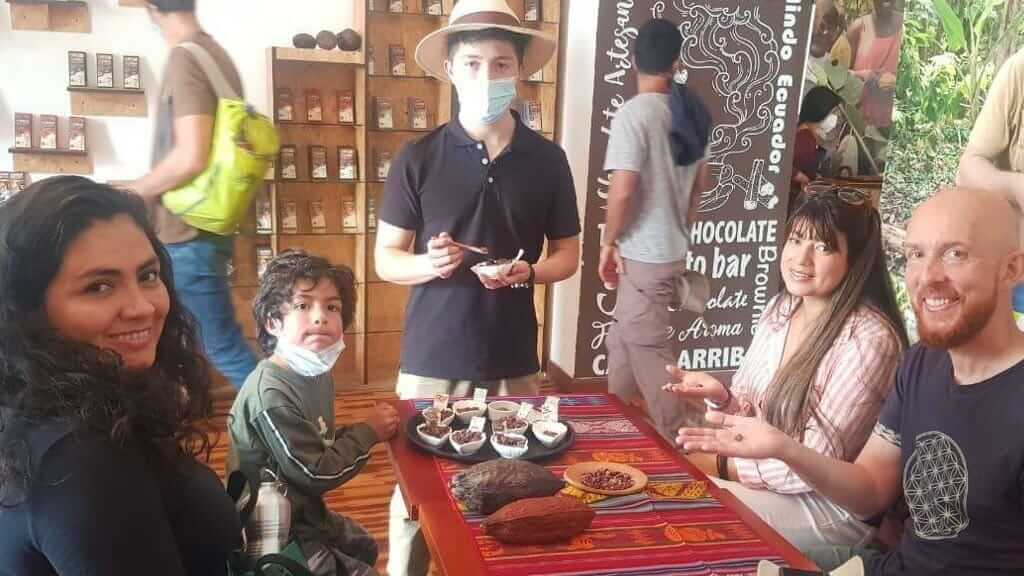
Contact us to organize an Ecuadorian chocolate tour experience. We custom-make tours right across the country and will be more than happy to include a memorable surprise for chocolate lovers.
If you found this blog useful and interesting, we recommend also checking out our posts about the Ecuador beer Revolution, Ecuadorian coffee, and Traditional food and drinks to try when visiting the country.
The #1 Trusted
Ecuador Travel Agency
In Conclusion, Ecuadorian chocolates are making a big name for themself on the global stage. Not only should we celebrate the high-quality fine dark chocolate and innovative flavors, but also the story of how sustainably grown cocoa is helping small communities to make a living. So, chocoholics, take some time out to sample chocolate from Ecuador’s different regions and take some home with you to spread the word. Ecuador is firmly back on the world chocolate map!

